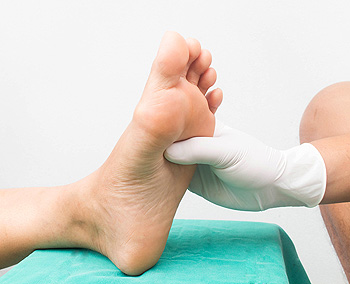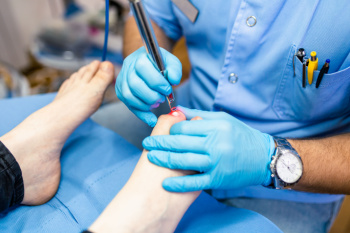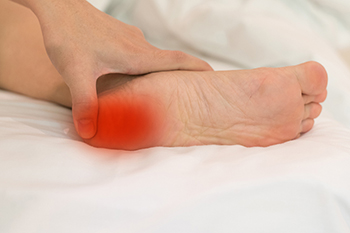Items filtered by date: October 2024
Choosing the Right Ankle Brace

Finding the right ankle brace after an injury depends on the type of injury incurred, the level of instability it caused, and amount of support needed. Lace-up ankle braces offer adjustable support and a snug fit, making them a common choice for people with mild ankle instability. Stirrup braces provide more rigid support, with a plastic shell that stabilizes the joint, ideal for moderate injuries. Hinged ankle braces offer maximum stability and allow for a better range of motion, often used for severe injuries or post-surgery recovery. Compression braces, made of flexible material, reduce swelling and provide light support. Hybrid braces combine certain features, offering customized stability. Each type of ankle brace has advantages, like support and pain reduction, but may also restrict motion or cause discomfort if not properly fitted. A podiatrist can assess your ankle injury, recommend the best brace for your needs, and ensure it fits properly to avoid complications. If you have an ankle injury and need a brace, it is suggested that you make an appointment with a podiatrist for an exam and evaluation.
Ankle pain can have many different causes and the pain may potentially be serious. If you have ankle pain, consult with one of our podiatrists from Suncoast Podiatry Associates. Our doctors will assess your condition and provide you with quality foot and ankle treatment.
Ankle pain is any condition that causes pain in the ankle. Due to the fact that the ankle consists of tendons, muscles, bones, and ligaments, ankle pain can come from a number of different conditions.
Causes
The most common causes of ankle pain include:
- Types of arthritis (rheumatoid, osteoarthritis, and gout)
- Ankle sprains
- Broken ankles
- Achilles tendinitis
- Achilles tendon rupture
- Stress fractures
- Tarsal tunnel syndrome
- Plantar fasciitis
Symptoms
Symptoms of ankle injury vary based upon the condition. Pain may include general pain and discomfort, swelling, aching, redness, bruising, burning or stabbing sensations, and/or loss of sensation.
Diagnosis
Due to the wide variety of potential causes of ankle pain, podiatrists will utilize a number of different methods to properly diagnose ankle pain. This can include asking for personal and family medical histories and of any recent injuries. Further diagnosis may include sensation tests, a physical examination, and potentially x-rays or other imaging tests.
Treatment
Just as the range of causes varies widely, so do treatments. Some more common treatments are rest, ice packs, keeping pressure off the foot, orthotics and braces, medication for inflammation and pain, and surgery.
If you have any questions, please feel free to contact our office located in Ocala, FL . We offer the newest diagnostic and treatment technologies for all your foot care needs.
Diagnosis and Treatment of Diabetic Neuropathy

Diabetic neuropathy occurs when high blood sugar levels damage the nerves in the feet, leading to symptoms such as numbness, tingling, and burning sensations. A podiatrist can diagnose diabetic neuropathy through various tests. Included are checking the response of your feet to temperature, touch, and reflexes to assess nerve function. Although nerve damage cannot be reversed, a podiatrist can help reduce the risk of complications by recommending regular foot inspections, managing foot ulcers promptly, and ensuring proper foot hygiene. Choosing the right footwear and inspecting shoes for potential hazards are also key steps in preventing further complications. Regular visits to a podiatrist can help monitor foot health and provide proper treatment should infections or deformities arise. If you have diabetic neuropathy that affects your feet, it is suggested that you make a podiatrist a part of your medical team to manage this condition.
Neuropathy
Neuropathy can be a potentially serious condition, especially if it is left undiagnosed. If you have any concerns that you may be experiencing nerve loss in your feet, consult with one of our podiatrists from Suncoast Podiatry Associates. Our doctors will assess your condition and provide you with quality foot and ankle treatment for neuropathy.
What Is Neuropathy?
Neuropathy is a condition that leads to damage to the nerves in the body. Peripheral neuropathy, or neuropathy that affects your peripheral nervous system, usually occurs in the feet. Neuropathy can be triggered by a number of different causes. Such causes include diabetes, infections, cancers, disorders, and toxic substances.
Symptoms of Neuropathy Include:
- Numbness
- Sensation loss
- Prickling and tingling sensations
- Throbbing, freezing, burning pains
- Muscle weakness
Those with diabetes are at serious risk due to being unable to feel an ulcer on their feet. Diabetics usually also suffer from poor blood circulation. This can lead to the wound not healing, infections occurring, and the limb may have to be amputated.
Treatment
To treat neuropathy in the foot, podiatrists will first diagnose the cause of the neuropathy. Figuring out the underlying cause of the neuropathy will allow the podiatrist to prescribe the best treatment, whether it be caused by diabetes, toxic substance exposure, infection, etc. If the nerve has not died, then it’s possible that sensation may be able to return to the foot.
Pain medication may be issued for pain. Electrical nerve stimulation can be used to stimulate nerves. If the neuropathy is caused from pressure on the nerves, then surgery may be necessary.
If you have any questions, please feel free to contact our office located in Ocala, FL . We offer the newest diagnostic and treatment technologies for all your foot care needs.
Safe Falling Strategies for Seniors and Prevention Tips

As people age, the risk of falling increases, making it essential to know how to fall safely. If a fall is unavoidable, try to relax your body, and aim to land on your side rather than your back or wrists to reduce injury risk. Tucking your chin toward your chest can help protect your head. Wearing appropriate shoes with good grip can prevent slips. Staying active with exercises that improve balance and strength enhances stability. Regular vision and health check-ups can also identify issues that increase fall risk. Creating a safe home environment by removing clutter, securing loose rugs, and installing grab bars in critical areas can further reduce chances of falls. Falling can injure the feet, as well as other body parts. If this has happened to you, it is suggested that you consult a podiatrist who can offer effective treatment methods and fall prevention tips.
Preventing falls among the elderly is very important. If you are older and have fallen or fear that you are prone to falling, consult with one of our podiatrists from Suncoast Podiatry Associates. Our doctors will assess your condition and provide you with quality advice and care.
Every 11 seconds, an elderly American is being treated in an emergency room for a fall related injury. Falls are the leading cause of head and hip injuries for those 65 and older. Due to decreases in strength, balance, senses, and lack of awareness, elderly persons are very susceptible to falling. Thankfully, there are a number of things older persons can do to prevent falls.
How to Prevent Falls
Some effective methods that older persons can do to prevent falls include:
- Enrolling in strength and balance exercise program to increase balance and strength
- Periodically having your sight and hearing checked
- Discuss any medications you have with a doctor to see if it increases the risk of falling
- Clearing the house of falling hazards and installing devices like grab bars and railings
- Utilizing a walker or cane
- Wearing shoes that provide good support and cushioning
- Talking to family members about falling and increasing awareness
Falling can be a traumatic and embarrassing experience for elderly persons; this can make them less willing to leave the house, and less willing to talk to someone about their fears of falling. Doing such things, however, will increase the likelihood of tripping or losing one’s balance. Knowing the causes of falling and how to prevent them is the best way to mitigate the risk of serious injury.
If you have any questions, please feel free to contact our office located in Ocala, FL . We offer the newest diagnostic and treatment technologies for all your foot care needs.
Pros and Cons of Laser Toenail Fungus Removal

Toenail laser treatment has gained popularity as a treatment for toenail fungal infections, offering a modern alternative to traditional methods. One significant advantage is its effectiveness, as lasers target infected tissue without harming surrounding areas, often resulting in quicker recovery times and minimal discomfort. Additionally, this procedure requires no anesthesia and can be completed in a short session, making it convenient for patients. However, there are also drawbacks to consider. The cost of laser treatment can be higher than conventional options, and multiple sessions may be necessary for optimal results. Furthermore, while the procedure is generally safe, some individuals may experience temporary side effects such as redness or swelling. If you have toenail fungus, it is suggested that you consult a podiatrist who can determine if laser treatment is right for you.
Laser treatment can be an effective way to get rid of toenail fungus. If you have any questions about laser treatment, consult with one of our podiatrists from Suncoast Podiatry Associates. Our doctors will assess your condition and provide you with quality treatment for fungal nails.
What Are Toenail Fungal Infections?
Onychomycosis, or fungal infection of the nail, is a relatively common and non-serious condition. Around 10 percent of U.S. citizens are afflicted with fungal nails. Common forms of fungus that infect the nail include dermatophytes, yeasts, and molds.
Symptoms of Toenail Fungal Infections Include:
- Nail thickening
- Brittleness of the nail
- Discoloration of the nail
Diagnosis for Fungal Nails
Fungal infections are diagnosed by fungal culture and microscopy. This will rule out any other conditions such as nail trauma, psoriasis, lichen planus, and onychogryphosis.
What Is Laser Treatment?
Laser treatment is a non-invasive, safe, quick, and painless procedure that uses the heat from a laser to kill fungus in the nail. Each infected nail is targeted with a laser for several minutes. The treatment is usually utilized several different times over a select period. During this time, a podiatrist will keep an eye on the infection.
If you have any questions, please feel free to contact our office located in Ocala, FL . We offer the newest diagnostic and treatment technologies for all your foot care needs.
Stop Your Toenail Fungus
Causes of Heel Pad Syndrome

Heel pad syndrome develops when the fatty tissue beneath your heel loses thickness or elasticity, causing discomfort with every step. This tissue normally serves as a shock absorber, but over time, aging and repetitive stress can cause it to break down. Particular factors that increase heel pad syndrome include running, being overweight, or frequently walking on hard surfaces. The resulting loss of cushioning leads to pain, typically felt in the center of the heel during standing for long periods, walking long distances, or running. A podiatrist can provide relief by prescribing custom orthotics or heel cups to redistribute pressure. Lifestyle changes that decrease stress on the heels and medication to reduce inflammation also help. Early diagnosis and treatment are essential to prevent further complications. If you are experiencing heel pain, it is suggested that you schedule an appointment with a podiatrist for treatment options.
Many people suffer from bouts of heel pain. For more information, contact one of our podiatrists of Suncoast Podiatry Associates. Our doctors can provide the care you need to keep you pain-free and on your feet.
Causes of Heel Pain
Heel pain is often associated with plantar fasciitis. The plantar fascia is a band of tissues that extends along the bottom of the foot. A rip or tear in this ligament can cause inflammation of the tissue.
Achilles tendonitis is another cause of heel pain. Inflammation of the Achilles tendon will cause pain from fractures and muscle tearing. Lack of flexibility is also another symptom.
Heel spurs are another cause of pain. When the tissues of the plantar fascia undergo a great deal of stress, it can lead to ligament separation from the heel bone, causing heel spurs.
Why Might Heel Pain Occur?
- Wearing ill-fitting shoes
- Wearing non-supportive shoes
- Weight change
- Excessive running
Treatments
Heel pain should be treated as soon as possible for immediate results. Keeping your feet in a stress-free environment will help. If you suffer from Achilles tendonitis or plantar fasciitis, applying ice will reduce the swelling. Stretching before an exercise like running will help the muscles. Using all these tips will help make heel pain a condition of the past.
If you have any questions please contact our office located in Ocala, FL . We offer the newest diagnostic and treatment technologies for all your foot and ankle needs.

